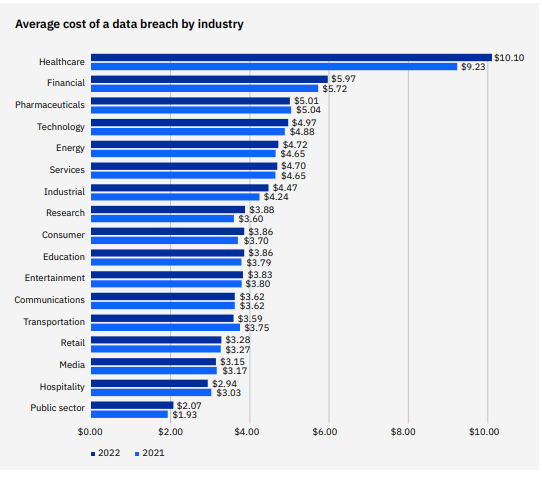In today's business world, data is everything. Thanks to the data your organization collects, you can make better decisions about how to run your newest campaign or make your product or service better for your customers. What would happen if you suddenly lost access to all of it? The damage to your business operation and brand image could be devasting.
If you work in a financial institution, taking good care of the data inside your system is especially important. Banks and financial services have terabytes of highly sensitive information on hand – credit card numbers, social security numbers, dates of birth, email address, phone numbers, etc.
Losing access to this data would be far more than just a nuisance – it could even lead to legal troubles for your business! However, most data loss cases can be prevented – and we'll show you how in this article.

The impact of data loss on the financial industry
IBM's Cost of a Data Breach Report 2022 estimated that the average cost of a data breach in the financial services industry was $5.97 million – the second highest only after the healthcare industry. It's even more shocking if you look at the statistics about how many businesses close after having a major breach.

Source: IBM
But considering how much data organizations collect and rely on for their day-to-day work, it shouldn't be surprising that any kind of data loss can significantly impact how a company functions.
If your organization loses access to essential files, storage devices, or even the entire database, then you have to spend time and money recovering or recreating these files from scratch. Add to this:
- Much lower productivity of your staff
- Downtime costs
- Costs of hiring an IT team to investigate the data breach and recover your data
- Having to calm down upset customers
- Sometimes even needing to deal with legal fines for losing customer data (Which could cost you millions of dollars)
and you can see why taking good care of your business data should be a priority.
Consider this scenario: One or more computers in your network are infected with malware after an employee fell for a phishing scam. Because of this, you are now facing a major data breach. Besides having to work on finding the source of the breach and patching all security vulnerabilities, you'll also have to notify your partners, shareholders, customers, and in some cases, government agencies.
The image and reputation of your brand can suffer as a result – Forbes Insight report found that 46% of organizations suffered reputational damage from a data breach. So even if your company can recover the lost data, you’ll need to spend time rebuilding partner and customer relationships and restoring their trust in you.
The good news here is that data loss risk can be significantly minimized if you know what the biggest culprits are and take steps to prevent them from happening.
The causes of data loss in the financial industry
The biggest problem with data loss and breaches is that they can come in all shapes and sizes – from accidental file overwriting or unexpected power cut to malicious attacks from outside and hardware failure. In addition, the recent shift to remote working made protecting the data inside the system even more difficult as employees can now work from any place they wish, and on any device they have near – which also can pose a risk to the financial data’s security.
Here are the most common causes of data loss:
Natural disasters
Natural disasters like floods, earthquakes, or thunderstorms can damage the servers or physical drives and make the data stored unusable. Moreover, if all your data is stored in one location at the time of the disaster, you risk losing it all without any way to retrieve it.
Human errors
Based on the Verizon Data Breach report, the cause of 82% of all data breaches in 2021 were human errors. From accidentally deleting or overwriting an important file to spilling liquids on the keyboard or falling for a phishing email – all those situations can result in the employee losing access to data.
cyber threats and device infection
According to the ITRC's yearly report on data breaches, 92% of data compromising incidents in the first quarter of 2022 were a result of some form of cyberattack. The types of attacks are various as well – phishing, ransomware, DDoS and malware attacks can all result in your data being either corrupted or compromised. Ransomware attacks are especially dangerous as they encrypt the entire data on an infected computer and demand a ransom for giving access to the data back. Phishing scams are unfortunately widespread as well though – according to Verizon, phishing is involved in 36% of breaches.
desktop_windows
Hardware failure
Overheating, current spikes or sudden power cut, firmware corruption, failed upgrades, or human mistakes can cause hard drives, servers, or external hard drives to fail. In fact, it's estimated that around 140 thousand hard drives crash every week, with 60% of these crashes being caused by mechanical issues and 40% by human error.
broken_image Corrupted or lost data during data migration
Moving the financial data from one system/database to another needs to be done very carefully as there's the risk that some part of the data might be lost or corrupted during the process. Keeping an eye on the data migration is especially important during the merger and acquisition process, as losing a part of the financial data can lead to several problems later on.
As you can see, a number of things can cause your office to suddenly lose access to the data it needs – some of those can't be predicted. The good news here is that often, the data on a given device isn't gone for good, and with the help of an IT specialist, you can get it back. The risk is that a part of the recovered data might be incomplete, outdated, or in the worst case, corrupted beyond repair.
That's why securing your data before a breach happens is so important – fortunately, you have plenty of ways to do so.
Prevention tactics for data loss
The single best thing you can do to prevent losing important financial documents or files is to regularly back up your database. Having two or more copies of your business data stored in different places can help you protect your organization both from human mistakes and hardware failure but malware and natural disasters as well. If it happens that you lose access to some part of your database (or even the entire one), then you can simply bring it back from a stored copy rather than having to remake the database from zero.
Currently, using cloud storage is one of the safest and most effective means of backing up data. As the data is stored on a remote server, organizations don't need to worry anymore about hardware failure – the data can be accessed on any device as long as there's an internet connection. Data security experts recommend though, that you store a copy of your data on a physical device (like an external hard drive) as well though, to ensure that you have both an online and offline data copy.
Apart from regularly backing up your data, there are a few other things you can do to protect your database:
Ensure your employees use strong, different passwords for all their accounts, email addresses and applications. A single leaked password is always checked for how many different applications it fits, so reusing one password for many applications might compromise the data from all those devices. A good tip here is to use a password manager to create and store strong passwords for all work-related applications and accounts.
Keep the antivirus, firewall, operational system, and all other applications used in your company regularly updated and all security flaws spotted patched. Code vulnerabilities inside the outdated applications or any security issues in your system might be a perfect target for hackers who will use those to enter your network.
Train your staff on how to protect data from being compromised. You can do this by teaching them how to create strong passwords, how often they should change theirs, what to do if their devices start malfunctioning and what to do when they get an email or phone call asking for their or their company's sensitive information. You should also consider setting security rules for accessing the company network or applications if your employees work remotely or use personal devices for work (like using a VPN and an application for encrypting data) - though ideally, they should only use their office devices for work.
Limit access to your most important data – In general, the more people who have access to a file or database, the higher the risk of the data being accidentally damaged or destroyed. Today, most cloud applications allow administrators to decide which employees have access to which data levels. By doing so, you can ensure that sensitive or confidential information is only accessible to those employees who need it or get permission from you to access the data.

How to get your business back on track after a data loss incident
By backing up the data, regularly changing your passwords, and ensuring that your team knows what to do when they get a phishing email, you can significantly lower the risk of data loss or security breach. Still, you can't completely eliminate the risk, so sooner or later, you might have to deal with a data loss incident yourself. Here's when having a set action plan can help you to act faster and minimize the damage caused by the data loss.
The following steps should be the basis of your data loss incident strategy:
- Assess the damage and actions you will need to recover the data
The first thing you should do is to check how serious the data loss problem is and what actions you can take straight away to minimize the impact. For example, if a staff member overwrote a few files by accident and you still have a copy of them, restoring them from that copy should be enough. Employees can also use cloud storage to keep their data accessible in case they would have to change computers (for example, due to a hardware failure).
If you've lost sensitive data or a large part of your database has been damaged by a cyber attack, then before taking any action, you need to investigate the problem first. What kind of data have you lost? Do you have any updated copies of it? Are there any other computers that are affected? Are there any compromised accounts in your network?
Based on the damage scale, you might need to cut infected computers from the database, revoke an employee's database permissions or shut the office system down to prevent the cyber attack from causing even more damage.
It's recommended to change all passwords or credentials your staff might be using as well since it will help stop the breach from spreading if it's going on.
- Call the IT team or reach out to data security professionals
If the data loss has been caused by malware infection or widespread hardware failure, then your best course of action is to immediately call an IT team or cybersecurity professionals team. By investigating the system logs, they will be able to determine where the breach may have originated, stop the infection from spreading, and provide advice on how to resolve the problem. They might also be able to recover some or the majority of the data that you have lost - there's the risk that the recovered data might be corrupted, though.
- Focus on restoring business operations
Depending on what caused the data loss in the first place, there will be different actions you will need to bring your company back on track. It might be restoring your files from backup and changing all passwords used, taking your service offline until you can patch the security vulnerabilities, cleaning the connected devices in your network, or working together with ransomware specialists.
This is also a good moment to ask the cybersecurity team to analyze your network, find the security flaws inside your system, and give you suggestions on how you could prevent data breaches in the future.
- Notify everyone who might be affected
Now for the potentially hardest thing – telling everyone who might be affected by the data loss about the incident. If the data loss was caused by an internal problem and it didn't involve sensitive data, then it might be enough to just inform your employees about the situation and new security measures that will be implemented.
The situation gets more serious when the data loss is more severe, and there's a risk that it might have gotten outside, since you have to comply with data breach regulations like General Data Protection Act. Under those, you are obliged to notify anyone who might be affected by the data breach not later than 72 hours after becoming aware of it.
The notification should include:
- What happened
- How you're fixing the issue
- What owners of the compromised accounts should do to protect themselves (like calling the financial's institution hotline to block their account or changing their authorization method)
This is a must-do. While there's the risk that such a notification might upset or anger your customers, trying to cover the issue might cause the situation to get much worse once the customers learn about the incident themselves. Besides losing their trust for good, you might also have to deal with legal fines for not informing your customers about the breach.
- Take steps to prevent future data loss incidents
Losing your business data, especially the one related to your customers, can be a severe blow to your finances – just an hour of downtime costs on average $8,000 for a small company, $74,000 for a medium company, and even $700,000 for a large enterprise. But more importantly, data loss can undermine your customers’ trust in your organization’s capabilities. The best way to regain their trust is to show them that you learned from the incident and are working hard to prevent it from happening again – by adding new authentication methods or working with cybersecurity experts on updating your security practices.
How Safetica can help you
As you can see, the consequences of data loss can be quite severe – so it’s better to be prepared in advance. By regularly backing up your data, changing your passwords, training your staff on how to respond to suspicious messages, and having a data loss emergency plan, you can minimize the risk of data breaches. Recently, companies also started to use Data Loss Prevention or DLP solutions like Safetica to protect their data from threats and damages as well. According to Statista, the DLP market revenues are projected to increase from 1.24 billion U.S. dollars in 2019 to 3.5 billion by the end of 2025 as organizations are starting to look for ways to secure their data from breaches and corruption.
Adding Safetica DLP to your regular data loss prevention strategy can enhance the security of your organization’s data in the following ways:
- Easier classifying and securing particularly important or sensitive data.
- Analyzing where and how your data is stored, transferred, or edited and finding places where there’s the highest risk of data loss.
- Helping you set user permissions required for accessing and editing each data type.
- Giving you real-time notifications about any policy violations or suspicious activities in your network.
- Protecting both data at rest (stored in your system) and the data currently used by your employees.
- Managing regulatory compliance regulations and preventing violations.
You don’t need any in-house hardware infrastructure to start Safetica either. Safetica works as a cloud-based data loss prevention service, which means all you need to do is install the Safetica client on your devices, and the platform will start protecting them automatically. The platform will also secure the data on all endpoints, all devices, all major operating systems, and the cloud as well – so you can be sure that all critical files are under control.
Conclusion
Losing corporate data isn’t just an inconvenience – the consequences can be devasting, especially if your company doesn’t have an up-to-date data backup ready. A data loss means lost productivity, lost time and budget spent on restoring the data, and, most importantly, lost trust from customers. So if you want to maximize the chances that you’ll recover from a data loss and protect yourself from a cyber-attack, you need to do what you can to prevent those incidents from happening – and have an emergency plan ready for unexpected situations.
Updating your data regularly and keeping your antivirus and firewall applications updated will help you keep your data in good shape. But Safetica can help you here as well by keeping an eye on your database and alerting you whenever it spots any suspicious activity. With up-to-date backups and Safetica at your side, you can now rest assured that your data is safe.

